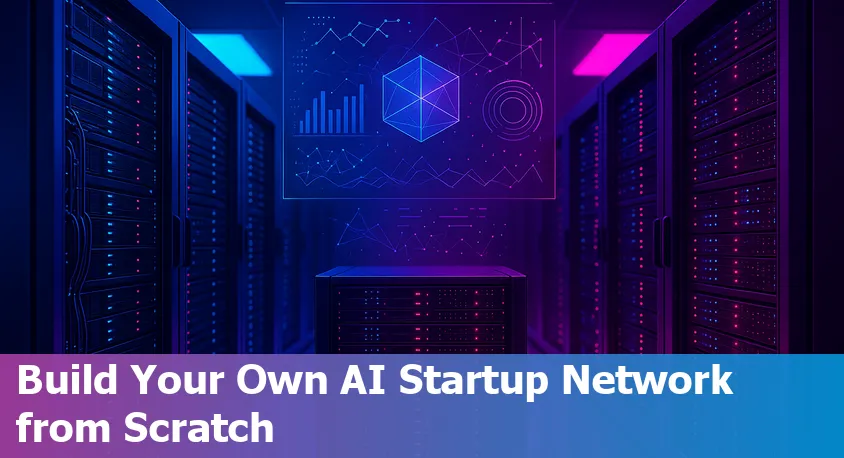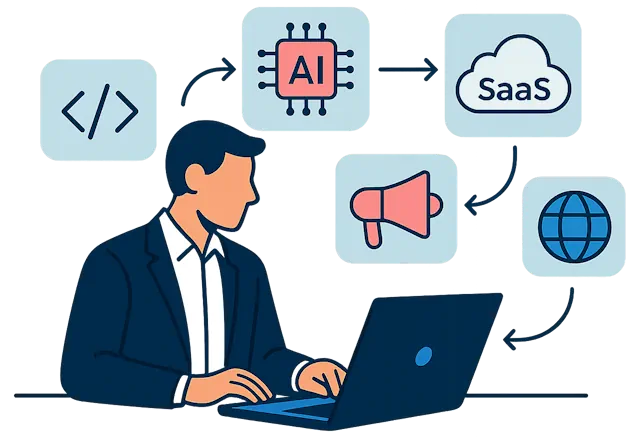Setting Up a Self-Hosted AI Startup Infrastructure: Best Practices
Last Updated: May 21st 2025

Too Long; Didn't Read:
Setting up a self-hosted AI startup infrastructure offers enhanced data privacy, regulatory compliance (GDPR, HIPAA), cost predictability, and control over intellectual property. Best practices include deploying high-performance GPUs/CPUs, securing robust storage and networking, choosing open-source models, implementing strong security, and building multidisciplinary MLOps teams.
For modern AI startups, the choice between cloud and self-hosted infrastructure isn't just technical - it's a matter of long-term business viability, privacy, and competitive advantage.
Self-hosting AI models on your own servers or private cloud empowers founders with greater control over sensitive data, improved regulatory compliance, and more predictable costs - crucial benefits as data privacy laws tighten globally and the cloud's variable pricing grows unpredictable.
As highlighted by industry experts,
“Self-hosting AI models is the future of privacy and compliance. By hosting AI models on personal hardware, individuals and businesses can improve data security while meeting strict regulations like the GDPR and HIPAA.”
Read more about the benefits of self-hosting AI models for privacy and compliance.
On-premise solutions also allow for superior customization and flexibility, making them particularly attractive for sectors like healthcare or finance where data sovereignty is paramount.
Learn about the benefits and implementation of self-hosted AI solutions.
However, this autonomy comes with increased investment in hardware, talent, and security. Ultimately, as AI becomes mission-critical, self-hosted infrastructure stands out as the best defense against unwanted data use and ensures your intellectual property remains just that - yours.
Discover why self-hosted AI may be your best defense against unwanted data training.
Table of Contents
- Understanding the Core Infrastructure Components for Your AI Startup
- Step-by-Step Guide to Setting Up Your Self-Hosted AI Stack
- Best Practices: Security, Compliance, and Cost Management
- Selecting the Right Tools, Models, and Service Providers
- Growing Skills and Team for Sustained Self-Hosted AI Success
- Conclusion: Building a Competitive, Compliant, and Scalable AI Startup
- Frequently Asked Questions
Find out how the cost to start an AI company in 2025 has plummeted, letting solo founders launch startups with minimal investment.
Understanding the Core Infrastructure Components for Your AI Startup
(Up)To build a future-ready AI startup, understanding the fundamental infrastructure components is critical for performance, scalability, and compliance. Core elements include high-performance computing resources such as GPUs (essential for parallel processing in model training), TPUs (optimized for deep learning and TensorFlow), and, in some cases, FPGAs or custom chips suited for specialized tasks.
Equally important are scalable storage solutions - ranging from network-attached storage and data lakes to cloud-based object storage - capable of efficiently managing structured and unstructured data streams.
High-speed networking underpins smooth operations and low-latency data transfer, particularly for real-time applications like fraud detection or autonomous vehicles.
Modern AI stacks also incorporate machine learning frameworks (e.g., TensorFlow, PyTorch), MLOps tools for orchestrating deployments, and robust security measures such as encryption and access controls to ensure data privacy.
As illustrated below, infrastructure decisions often balance deployment model, scalability requirements, and maintenance complexity:
| Feature | On-Premise Solutions | Cloud-Based Solutions | Hybrid Solutions |
|---|---|---|---|
| Deployment Model | Internal hardware | Third-party provider | Mix of on-premise and cloud |
| Scalability | Limited by hardware | Highly scalable | Flexible |
| Cost Structure | High upfront CapEx | Pay-as-you-go | Hybrid expenses |
| Security & Control | Maximum | Depends on provider | Balanced |
Orchestration tools like Kubernetes streamline workload scaling, and edge computing is gaining ground for real-time, latency-sensitive applications. For a comprehensive breakdown of the core components - including the latest in hardware, AI frameworks, and cloud integration - see this detailed 2025 AI infrastructure guide.
To compare hardware options and understand specialized requirements for AI model training versus inference, consider the insights on hardware needed for AI.
For a high-level overview of enterprise AI infrastructure trends, including leading provider comparisons and best practices, explore top AI infrastructure solutions for 2025.
Step-by-Step Guide to Setting Up Your Self-Hosted AI Stack
(Up)Setting up a self-hosted AI stack for your startup involves a sequence of carefully planned steps to ensure privacy, scalability, and long-term control. Begin by defining your use case and selecting open-source large language models (LLMs) such as Llama 2 or Mistral, based on your resource requirements and compliance needs.
Prepare the required hardware - ideally a server or cloud GPU instance with at least 16–32GB RAM and modern multi-core CPUs - and familiarize yourself with frameworks like Ollama, HuggingFace Transformers, or Ray Serve.
Next, automate infrastructure provisioning using tools such as Terraform and Docker Compose, streamlining deployment and configuration as demonstrated by guides for AWS, n8n Starter Kit, and Kubernetes-based solutions.
The deployment process typically includes cloning a starter repository, configuring environment variables, launching the model server, setting up vector databases (like Qdrant), and integrating with orchestration or workflow tools for RAG (Retrieval-Augmented Generation) capabilities.
Throughout this process, prioritize privacy by applying strong network security, role-based access controls, and regular system updates. As one practitioner notes,
“Self-hosting AI models represents a powerful approach for organizations prioritizing privacy, control, and customization. With open-source alternatives becoming increasingly sophisticated, the barriers to entry continue to lower.”
For a step-by-step technical walkthrough and optimized scripts, refer to this detailed AWS self-hosted AI deployment guide.
If you prefer a local, no-cloud setup including workflow automation, explore the n8n Self-Hosted AI Starter Kit.
For insights into best practices, hardware considerations, and tool selection, this comprehensive guide to self-hosted LLMs on Kubernetes is invaluable.
With these resources, your startup can build an AI infrastructure that is both robust and under your complete control.
Best Practices: Security, Compliance, and Cost Management
(Up)Adopting best practices in security, compliance, and cost management is essential for any AI startup seeking to leverage self-hosted infrastructure competitively and ethically.
Robust security frameworks begin with a “zero trust” philosophy, strong role-based access controls, and enterprise-grade encryption throughout data lifecycles - at rest, in transit, and during processing.
Automated monitoring, continuous auditing, and third-party compliance software (like OneTrust or TrustArc) simplify adherence to leading data privacy standards such as GDPR, HIPAA, CCPA, and NIST by identifying gaps and generating regulator-ready reports with proven data privacy compliance frameworks.
Embedding privacy by design, anonymization, and minimization directly into AI systems not only builds customer trust but also sharply reduces breach and regulatory risks as outlined in AI data privacy best practices.
Regulatory compliance remains crucial - stricter frameworks like GDPR and HIPAA define consent, breach notification, and user rights, and non-compliance can result in fines up to €20 million or 4% global revenue.
A side-by-side comparison illustrates the distinct requirements of HIPAA and GDPR, with GDPR demanding broader consent and data deletion rights, while HIPAA places greater focus on US healthcare data.
| Aspect | HIPAA | GDPR |
|---|---|---|
| Jurisdiction | US healthcare | Organizations handling EU/UK data |
| Consent | Some non-consensual use allowed | Consent always required |
| Data Deletion | No right to be forgotten | Right to erasure |
| Breach Notification | Notify in 60 days if >500 affected | Notify authority in 72 hours |
For technical guidance on bolstering security throughout your AI stack, see detailed steps to secure your AI infrastructure the right way.
Selecting the Right Tools, Models, and Service Providers
(Up)Choosing the right combination of tools, models, and service providers is pivotal for building robust, scalable, and future-ready self-hosted AI startup infrastructure.
The core decision often centers around leading frameworks - namely, PyTorch and TensorFlow - with PyTorch preferred for research, rapid prototyping, and dynamic experimentation, while TensorFlow dominates in production deployment, large-scale scalability, and cross-platform readiness.
Model-serving tools are equally essential, and a comparative analysis reveals options such as BentoML, TensorFlow Serving, TorchServe, Nvidia Triton, and Titan Takeoff, each excelling in areas like framework support, deployment complexity, and performance optimization.
For instance, BentoML offers high multi-framework compatibility and ease of use, whereas Nvidia Triton is geared toward teams with access to Nvidia GPUs and advanced performance needs.
Here's a summary table to guide selection:
| Runtime | Framework Support | Complexity | LLM Support | Pricing |
|---|---|---|---|---|
| BentoML | High (PyTorch, TF, etc.) | Low | Yes | Free/Paid |
| TensorFlow Serving | TF only | Medium | No | Free |
| TorchServe | PyTorch only | Medium | No | Free |
| Nvidia Triton | High | High | Yes | Free |
| Titan Takeoff | LLM focused | Low | Yes | Paid |
Thorough evaluation of integration capabilities, team expertise, infrastructure fit, cost structure, and support channels is critical - as is proof-of-concept testing before committing.
For deeper insights into real-world deployment strategies and the evolving model serving landscape, explore comprehensive reviews in this guide to the best ML model serving tools and get practical advice on navigating rollout challenges from experienced practitioners here.
This balanced approach ensures your stack not only meets current needs but is also positioned to adapt as your AI startup grows.
Growing Skills and Team for Sustained Self-Hosted AI Success
(Up)Building and sustaining a successful self-hosted AI startup infrastructure hinges on nurturing a team with a blend of MLOps, DevOps, and AI engineering skills.
A culture of collaboration is vital, as MLOps professionals bridge the gap between data scientists and IT engineering, ensuring seamless deployment and management of machine learning models in production.
Essential competencies include proficiency in Python, containerization with Docker, orchestration with Kubernetes, and familiarity with CI/CD pipelines, alongside fluency in cloud platforms like AWS, Azure, or Google Cloud.
As the industry increasingly turns to generative AI for boosting productivity, managers should foster AI adoption thoughtfully, providing tools, oversight, realistic expectations, and continuous learning opportunities to maximize the benefits across all experience levels (best practices for managing generative AI in DevOps).
Real-world insights from tech startups highlight a typical tool stack combining version control (GitHub), ML frameworks (PyTorch, TensorFlow), and orchestration tools (Kubeflow, Airflow, MLflow), while emphasizing that a team's agility and mindset are its most valuable assets:
“Wetware – the hardware and software combination that sits between your ears – is the most important, most useful, most powerful machine learning tool you have.”(tool stack for ML teams at startups).
To accelerate growth, prioritize hands-on projects, cloud certifications, and mentorship, as well as mastery of the latest AI/ML libraries and platforms. For a comprehensive list of high-demand skills and frameworks that will define MLOps and AI engineering roles through 2025, consult this essential AI engineer skills guide, and empower your team to adapt swiftly as the field continues to evolve.
Conclusion: Building a Competitive, Compliant, and Scalable AI Startup
(Up)Building a competitive, compliant, and scalable AI startup in today's landscape means intentionally weaving together robust technical infrastructure, strategic adoption of AI tools, and best-in-class operational practices.
Startups that excel prioritize core infrastructure - high-performance GPU/CPU resources, scalable storage, and resilient networking - while leveraging open-source models like Llama 2 for cost efficiency and data privacy through self-hosted AI models.
Success also hinges on meticulous data governance, continuous monitoring, and integration of MLOps platforms, ensuring compliance with evolving regulations like GDPR and CCPA and protecting sensitive information at every layer with secure, scalable AI infrastructure practices.
As highlighted by industry leaders, strategic adoption of task-specific, fine-tuned models, the smart use of retrieval augmentation, and the building of strong data pipelines are keys for startups developing proprietary advantages:
“Strategic and iterative AI adoption - starting small, experimenting, and refining - is key. Sustainable implementation with adaptability and regulatory compliance positions startups for success in the AI-driven future.”
Explore top AI startup strategies here.
By mastering these foundational elements, founders not only position themselves for robust business growth but also instill lasting trust and operational resilience for their customers and stakeholders.
Frequently Asked Questions
(Up)What are the key benefits of self-hosting AI infrastructure for startups?
Self-hosting AI infrastructure gives startups greater control over sensitive data, aids in regulatory compliance (e.g., GDPR, HIPAA), enables predictable long-term costs, and offers maximum data privacy. It also allows for superior customization - especially important for industries with strict data sovereignty requirements.
What core components are needed to set up a self-hosted AI stack?
Core components include high-performance computing resources (GPUs, TPUs, FPGAs), scalable storage solutions, high-speed networking, machine learning frameworks (like TensorFlow, PyTorch), MLOps and orchestration tools (such as Kubernetes), and robust security controls (encryption, access management).
What are best practices for security and compliance in a self-hosted AI environment?
Best practices include implementing zero trust security principles, strong role-based access controls, encryption of data in transit and at rest, regular audits, and using compliance tools to meet standards like GDPR, HIPAA, and CCPA. Privacy-by-design, regular system updates, and continuous monitoring are also essential.
Which tools and frameworks should AI startups consider when building self-hosted infrastructure?
Startups should evaluate AI frameworks such as PyTorch (favored for research) and TensorFlow (preferred for production). For model-serving, options include BentoML, TensorFlow Serving, TorchServe, Nvidia Triton, and Titan Takeoff, each with its own strengths in compatibility, deployment complexity, and performance.
How can startups build and grow a team competent in managing self-hosted AI infrastructure?
Successful teams blend MLOps, DevOps, and AI engineering skills, including Python proficiency, knowledge of Docker/Kubernetes, CI/CD, and cloud platform experience. Fostering collaboration, continuous learning, and adoption of AI in workflows, plus investing in certifications and mentorship, ensures sustainable growth and adaptability.
Level-up your outreach with seamless AWS SES integration for AI email tailored for startups focused on cost and deliverability.
Stay ahead of the curve by uncovering future trends in AI-powered software testing set to redefine the startup landscape in 2025.
Be inspired by examples of real-world AI monitoring platforms used by leading startups in the evolving tech landscape.
Discover how implementing effective prioritization frameworks can dramatically boost your productivity as a solo AI founder.
Get inspired by examples of effective email campaign types that drive results at different stages of growth.
Discover how Notion AI for project management can help you streamline your solo startup tasks and stay organized in 2025.
Take the first step in transforming your startup's support by getting started with chatbots designed for maximum growth and efficiency.
Understand the critical distinction between internationalization versus localization to streamline your journey to 13-language readiness.
Ludo Fourrage
Founder and CEO
Ludovic (Ludo) Fourrage is an education industry veteran, named in 2017 as a Learning Technology Leader by Training Magazine. Before founding Nucamp, Ludo spent 18 years at Microsoft where he led innovation in the learning space. As the Senior Director of Digital Learning at this same company, Ludo led the development of the first of its kind 'YouTube for the Enterprise'. More recently, he delivered one of the most successful Corporate MOOC programs in partnership with top business schools and consulting organizations, i.e. INSEAD, Wharton, London Business School, and Accenture, to name a few. With the belief that the right education for everyone is an achievable goal, Ludo leads the nucamp team in the quest to make quality education accessible


